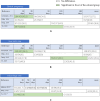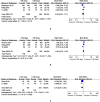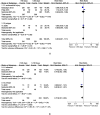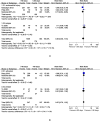Optimal timing to transfer embryos for women who underwent hysteroscopy: a systematic review and meta-analysis
- PMID: 40241018
- PMCID: PMC12004846
- DOI: 10.1186/s12884-025-07511-5
Optimal timing to transfer embryos for women who underwent hysteroscopy: a systematic review and meta-analysis
Abstract
Objective: This study aimed to investigate the optimal time interval between hysteroscopy and embryo transfer.
Methods: Electronic databases including PubMed, Embase, and Cochrane Library were searched up to Jul 2021. Two authors selected the articles independently and extracted data regarding study characteristics, quality, and results. A random-effect model was employed, and summary risk ratios (RR) at 95% confidence intervals (CI) were calculated.
Results: A total of 2123 patients from 5 studies were included. Pooled results showed that no significant differences for clinical pregnancy rates within 50-day and 90-day time interval comparison groups (RR = 0.83, 95% CI 0.61-1.11, P = 0.21; and RR = 0.91, 95% CI 0.74-1.12, P = 0.38, respectively), whereas clinical pregnancy rate was significantly increased in patients with a waiting interval of ≤ 120 days (RR = 0.75, 95% CI 0.61-0.93, P = 0.009). Subgroup analysis demonstrated that transferring embryos within 50 days for patients with normal uterine cavities was associated with a higher live birth rate (RR = 0.71, 95% CI 0.54-0.95, P = 0.02).
Conclusion: This meta-analysis identified that performing embryo transfer within 120 days for patients who underwent adhesiolysis and polypectomy within 50 days for patients who underwent diagnostic hysteroscopy was associated with superior outcomes, respectively. These findings may provide evidence to guide clinical decisions for reproductive clinicians. The conclusions might be limited by the small publication numbers. Further studies with a larger sample size were recommended.
Keywords: Assisted reproduction technique; Embryo transfer; Hysteroscopy; Pregnancy; Uterine cavity.
© 2025. The Author(s).
Conflict of interest statement
Declarations. Ethics approval and consent to participate: Not applicable. Consent for publication: Not applicable. Competing interests: The authors declare no competing interests.
Figures








Similar articles
-
Screening hysteroscopy in subfertile women and women undergoing assisted reproduction.Cochrane Database Syst Rev. 2019 Apr 16;4(4):CD012856. doi: 10.1002/14651858.CD012856.pub2. Cochrane Database Syst Rev. 2019. PMID: 30991443 Free PMC article.
-
Number of embryos for transfer following in vitro fertilisation or intra-cytoplasmic sperm injection.Cochrane Database Syst Rev. 2020 Aug 21;8(8):CD003416. doi: 10.1002/14651858.CD003416.pub5. Cochrane Database Syst Rev. 2020. PMID: 32827168 Free PMC article.
-
Efficacy of Hysteroscopy in Improving Fertility Outcomes in Women Undergoing Assisted Reproductive Technique: A Systematic Review and Meta-Analysis of Randomized Controlled Trials.Gynecol Obstet Invest. 2023;88(6):336-348. doi: 10.1159/000534794. Epub 2023 Oct 27. Gynecol Obstet Invest. 2023. PMID: 37899034 Free PMC article.
-
Endometrial injection of embryo culture supernatant for subfertile women in assisted reproduction.Cochrane Database Syst Rev. 2020 Aug 14;8(8):CD013063. doi: 10.1002/14651858.CD013063.pub2. Cochrane Database Syst Rev. 2020. PMID: 32797689 Free PMC article.
-
Does septum resection improve reproductive outcomes for women with a septate uterus? A systematic review and meta-analysis.Front Endocrinol (Lausanne). 2024 Jul 22;15:1361358. doi: 10.3389/fendo.2024.1361358. eCollection 2024. Front Endocrinol (Lausanne). 2024. PMID: 39104816 Free PMC article.
References
-
- Cevrioglu AS, Esinler I, Bozdag G, Yarali H. Assessment of endocervical and endometrial damage inflicted by embryo transfer trial: a hysteroscopic evaluation. Reprod Biomed Online. 2006;13(4):523–7. - PubMed
-
- Mansour R, Aboulghar M, Serour G. Dummy embryo transfer: a technique that minimizes the problems of embryo transfer and improves the pregnancy rate in human in vitro fertilization. Fertil Steril. 1990;54(4):678–81. - PubMed
-
- Fatemi HM, Popovic-Todorovic B. Implantation in assisted reproduction: a look at endometrial receptivity. Reprod Biomed Online. 2013;27(5):530–8. - PubMed
-
- Evans J, Salamonsen LA, Winship A, Menkhorst E, Nie G, Gargett CE, Dimitriadis E. Fertile ground: human endometrial programming and lessons in health and disease. Nat Rev Endocrinol. 2016;12(11):654–67. - PubMed
-
- Liu C, Yao W, Yao J, Li L, Yang L, Zhang H, Sui C. Endometrial extracellular vesicles from women with recurrent implantation failure attenuate the growth and invasion of embryos. Fertil Steril. 2020;114(2):416–25. - PubMed
Publication types
MeSH terms
Grants and funding
LinkOut - more resources
Full Text Sources

